Design and Validation of an Augmented Reality Teaching System for Primary Logic Programming Education
Abstract
:1. Introduction
- Teacher resources: This is the primary challenge faced by most counties and cities. Even in counties and cities that advocate programming courses in primary and secondary schools, teacher resources are still a challenge;
- Suitability of teaching materials: With rapid development of science and technology, if teachers simply lecture using paper teaching materials, there may be a disconnect from the current development of industrial technology;
- Insufficient information equipment: Programming relies on a large number of information equipment. Schools in rural and remote areas have relatively insufficient resources in this regard, and information equipment is relatively backward;
- Articulation of curricula: If students start to learn programming without any foundation, the learning process may add some burden on their study load. In addition to the regular basic courses, they also must learn and practice programming.
- In terms of assisting teachers in teaching, this study proposes an AR-based teaching system that allows users to learn logic programming through smartphones, thereby transforming teachers who originally served as the chief channel of knowledge impartation into a learning facilitator;
- In terms of teaching material design, this study validates that adding AR functions and appropriate gamification elements to the logic programming courses can effectively stimulate students’ learning motivation;
- In terms of simplifying teaching equipment, the proposed AR-based logic programming teaching system frees the learning of logic programming from the limitations of computer equipment. Students can learn with smartphones, which are very popular and easy to use.
2. Research Method
2.1. Participants
2.2. Design
2.2.1. Questionnaire Survey
2.2.2. Questionnaire Analysis Method
2.3. Teaching Experiment
2.4. Research Instruments
2.4.1. Learning Effectiveness Questionnaire
- The filling of demographic information;
- The logic programming integrating into life issues;
- The logic programming concepts;
- The application of logic programming concepts.
- Logic programming integrated with life issues;
- Logic programming concepts;
- Application of logic programming concepts;
2.4.2. ARCS Learning Motivation Questionnaire
3. The Proposed System
3.1. Concept of the Proposed AR-Based Logic Programming Teaching System
3.2. Platform
3.2.1. AR Environment
3.2.2. Command Block Design
4. Results and Discussion
4.1. Analysis of Learning Effectiveness
4.1.1. Test of Intra-Group Homogeneity of Regression Slopes
4.1.2. ANCOVA Results
4.2. Analysis of Learning Motivation
4.2.1. Attention
4.2.2. Relevance
4.2.3. Confidence
4.2.4. Satisfaction
5. Discussion
6. Conclusions and Future Work
Author Contributions
Funding
Institutional Review Board Statement
Informed Consent Statement
Data Availability Statement
Conflicts of Interest
References
- Liu, C.C. The Educational Wave of Computational Thinking and Programmin. Humanit. Soc. Sci. Newsl. Q. 2019, 20, 89–92. Available online: https://www.most.gov.tw/most/attachments/8c2fde59-6c05-45d1-90e1-7b83ac5dc233 (accessed on 14 November 2021).
- Grover, S.; Pea, R. Computational thinking in K–12: A review of the state of the field. Educ. Res. 2013, 42, 38–43. [Google Scholar] [CrossRef]
- Zhang, L.; Nouri, J. A systematic review of learning computational thinking through Scratch in K-9. Comput. Educ. 2019, 141, 103607. [Google Scholar] [CrossRef]
- K-12 Computer Science Framework Steering Committee. K-12 Computer Science Framework. 2016. Available online: http://k12cs.org/ (accessed on 14 November 2021).
- Jonassen, D.H. Computers in the Classroom: Mindtools for Critical Thinking; Prentice-Hall, Inc.: Hoboken, NJ, USA, 1996. [Google Scholar]
- Winslow, L.E. Programming pedagogy—A psychological overview. ACM SIGCSE Bull. 1996, 28, 17–22. [Google Scholar] [CrossRef]
- Shi, Y.-Y. The Dilemma and Prospect of Taiwan’s Programmatic Education. Taiwan Educ. Rev. Mon. 2018, 7, 1–8. [Google Scholar]
- Central News Agency. Artificial Intelligence Machine Learning is Required for Teacher Training Courses. 2019. Available online: https://udn.com/news/story/6885/3871417%E9%BB%83%E5%BF%97%E5%81%89 (accessed on 14 November 2021).
- Guo, B.-C. AI Education x Education AI. Ministry of Education. 2019. Available online: https://ccds2019.ndhu.edu.tw/ezfiles/204/1204/img/3852/20190627_keynote_speech_B.pdf (accessed on 14 November 2021).
- Hsieh, M.-C. Development and application of an augmented reality oyster learning system for primary marine education. Electronics 2021, 10, 2818. [Google Scholar] [CrossRef]
- Tasi, C.-Y.; Ho, Y.-C.; Nisar, H. Design and validation of a virtual chemical laboratory—An example of natural science in elementary education. Appl. Sci. 2021, 11, 1–21. [Google Scholar]
- Keller, J.M. Strategies for stimulating the motivation to learn. Perform. Instr. 1987, 26, 1–7. [Google Scholar] [CrossRef]
- Wu, W.-Z. “Playing is the Greatest Learning in Life!”—Towards a Gamified Learning Path. Flipping Education. 2020. Available online: https://flipedu.parenting.com.tw/article/5804 (accessed on 14 November 2021).
- Evripidou, S.; Amanatiadis, A.; Christodoulou, K.; Chatzichristofis, S.A. Introducing algorithmic thinking and sequencing using tangible robots. IEEE Trans. Learn. Technol. 2021, 14, 93–105. [Google Scholar] [CrossRef]
- Chang, C.-H. Changing Research approach for develeping educational psychology as an independent discipline. Bull. Educ. Psychol. 1996, 28, 1–14. [Google Scholar]
- Vosinakis, S.; Anastassakis, G.; Koutsabasis, P. Teaching and learning logic programming in virtual worlds using interactive microworld representations. Br. J. Educ. Technol. 2018, 49, 30–44. [Google Scholar] [CrossRef]
- K-12 Education Administration, Ministry of Education. P-IV-2 Structured Programming. 2019. Available online: https://ecc.pro.edu.tw/BackEnd/TR_Watch/Index/7d94c4f0-5778-4337-a2dd-02c435a41fe3 (accessed on 14 November 2021).
- Keller, J.M. Motivational Design of Instruction. In Instructional Design Theories and Models: An Overview of Their Current Status; Lawrence Erlbaum Associates: Mahwah, NJ, USA, 1983; pp. 383–434. [Google Scholar]
- Yen, S.-C. An Action Study of Appling “ARCS Motivation Model” in English Remedial Instruction for Underachieved Students in an Elementary School. Master’s Thesis, National Taichung University of Education, Taichung, Taiwan, January 2010. [Google Scholar]
- Wang, T.-Y. The Effects of an Augmented Reality and ARCS-based Mobile Learning System on Students’ Learning Achievement, Motivation and Flow Experience for Elementary School Astronomy Course. Master’s Thesis, National Chung Hsing University, Taichung, Taiwan, July 2019. [Google Scholar]
- Hsu, K.-T. A Study on the Use of the ARCS Model and Mobile Device Integrated into Junior High School Geography Teaching; Fo Guang University: Yilan, Taiwan, 2020. [Google Scholar]
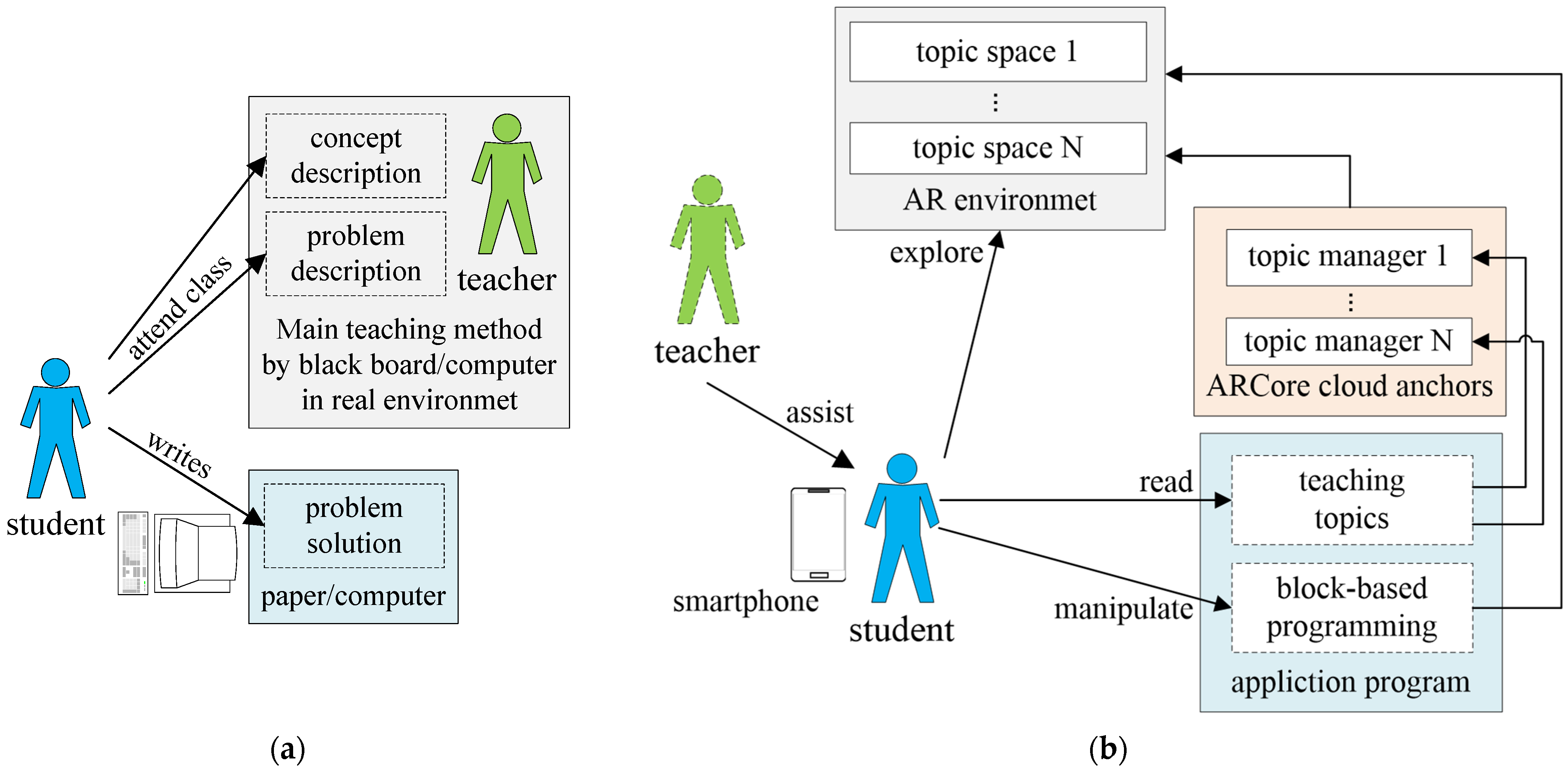
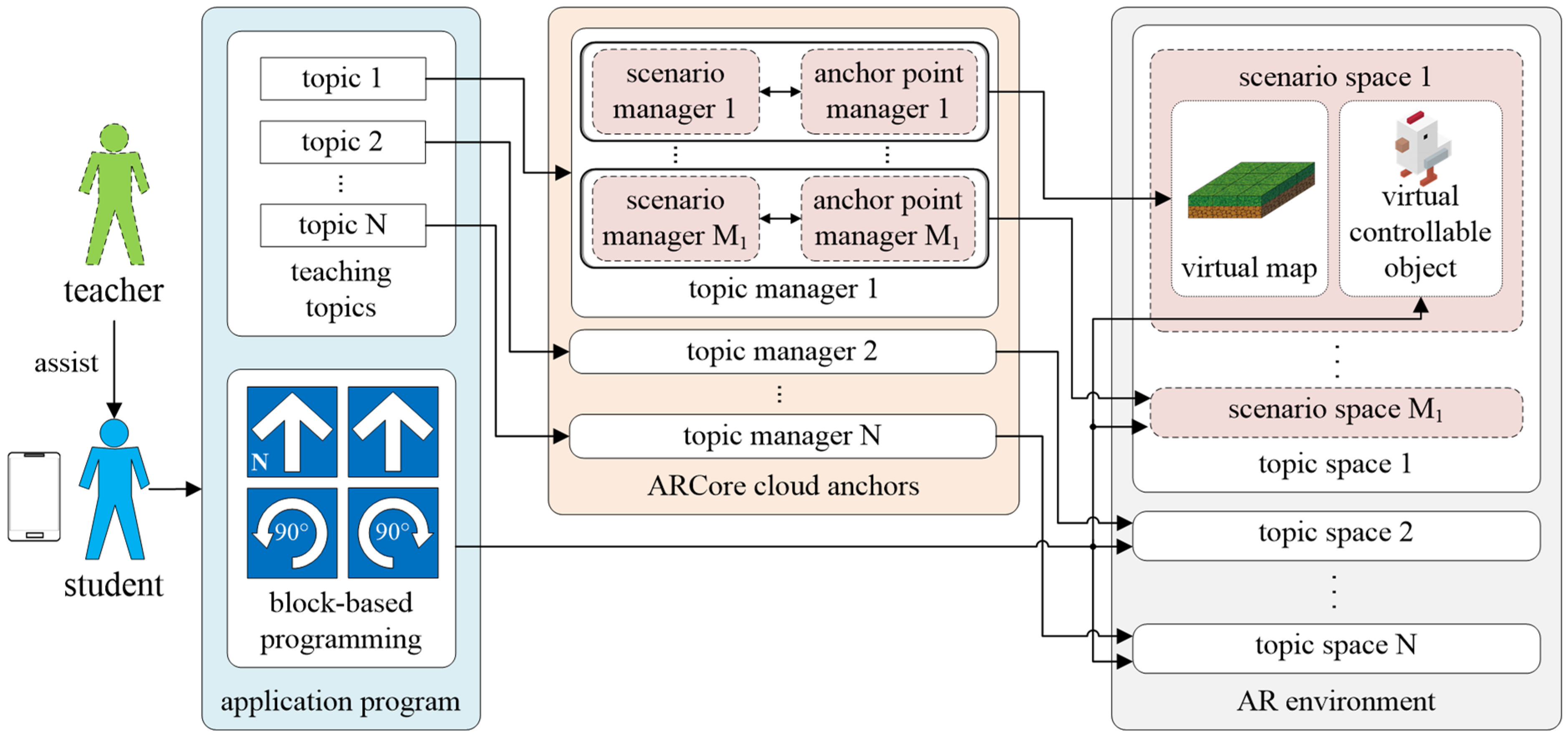

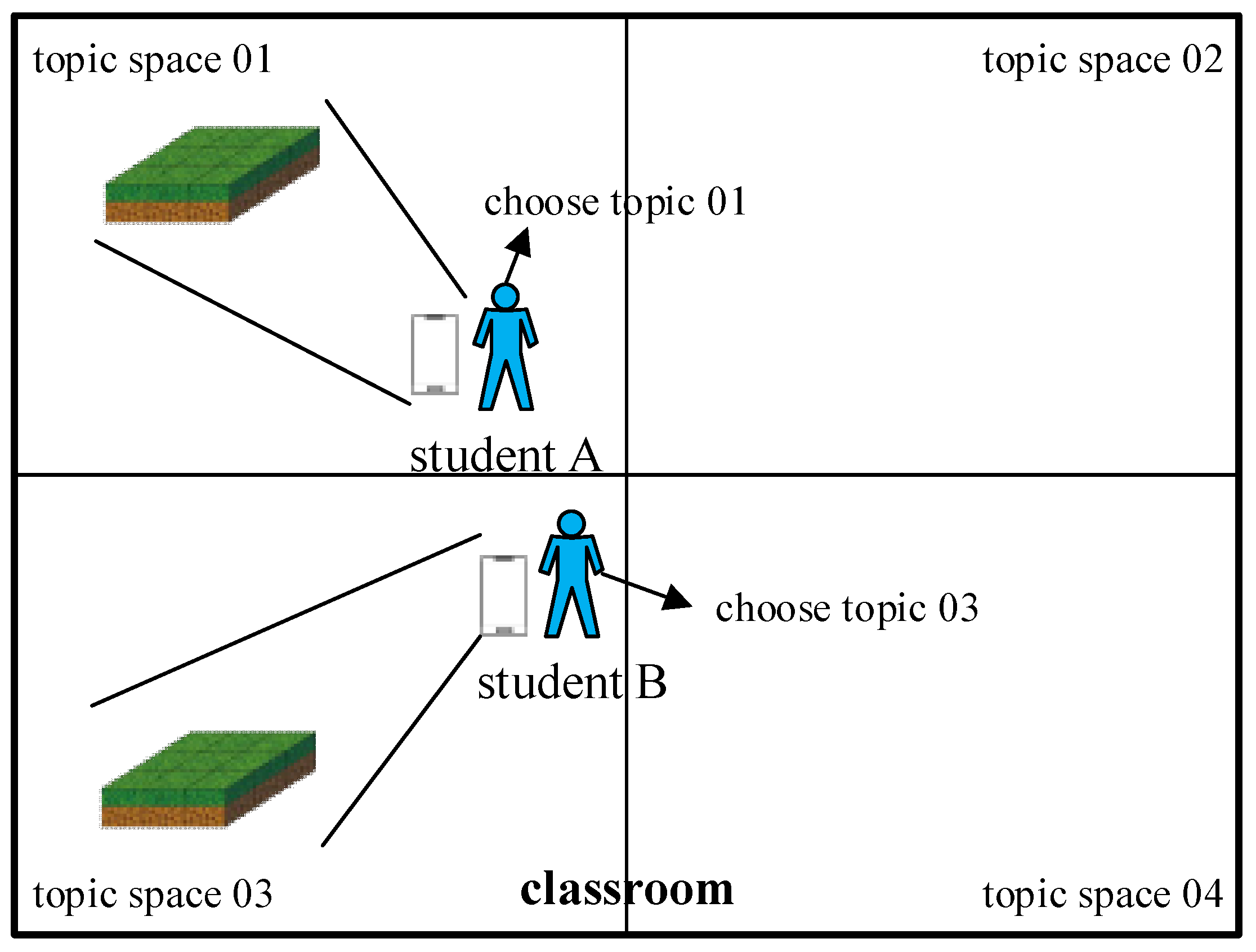
| Dimension of Learning Motivation | Question Number | Reverse Question |
|---|---|---|
| Attention | 1, 2, 3, 4, 5 | 1 |
| Relevance | 6, 7, 8, 9, 10 | 7 |
| Confidence | 11, 12, 13, 14, 15 | 13 |
| Satisfaction | 16, 17, 18, 19, 20 | 16 |
| Command | Function | Command | Function |
|---|---|---|---|
 | Go one block forward |  | Go N block forward |
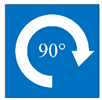 | Turn right 90 degrees | 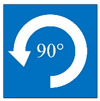 | Turn left 90 degrees |
| Theme | Mission | Learning Content | CT Concept | |
|---|---|---|---|---|
| Topic 1: Sequence | Move the animals to the correct food through command programming | Command | Forward, Left, Right | Sequence, events, data |
| Virtual generation |
| |||
| Learning focus | Use commands to control animals to move to the target food | |||
| Topic 2: Selection | Command | Forward, Left, Right | Sequence, events, data, conditionals | |
| Virtual generation |
| |||
| Learning focus | Determine the food corresponding to the animal, and use commands to control the animal to move to the target food | |||
| Topic 3: Repetition | Command | Repeat forward, Left, Right | Sequence, events, data, conditionals, loops | |
| Virtual generation |
| |||
| Learning focus | Simplify the original order schedule with the repeat function | |||
| Source of Variance | Sum of Squares | Degree of Freedom | Mean Sum of Squares | F-Test | p-Value |
|---|---|---|---|---|---|
| Pretest | 1769.564 | 1 | 1769.564 | 41.034 | <0.001 * |
| Group | 229.251 | 1 | 229.251 | 5.316 | 0.027 * |
| Pretest × Group | 120.884 | 1 | 120.884 | 2.803 | 0.102 |
| Deviation | 1638.739 | 38 | 43.125 | - | - |
| Group | Number of Subjects | Mean Score | Standard Deviation | |||
|---|---|---|---|---|---|---|
| Pretest | Posttest | Pretest | Posttest | Pretest | Posttest | |
| AR-based learning group | 22 | 22 | 68.27 | 91.68 | 2.944 | 1.545 |
| Traditional learning group | 20 | 20 | 71.05 | 85.75 | 2.924 | 2.487 |
| Source of Analysis | Type III Sum of Squares | Degree of Freedom | Mean Sum of Squares | F-Test | p-Value |
|---|---|---|---|---|---|
| Pretest score | 1692.899 | 1 | 1692.899 | 37.521 | <0.001 * |
| Group | 548.132 | 1 | 548.132 | 12.149 | 0.001 * |
| Deviation | 1759.623 | 39 | 45.119 |
| Group | Mean Score | Standard Deviation | 95% Confidence Interval | |
|---|---|---|---|---|
| Lower Limit | Upper Limit | |||
| AR-based learning group | 92.321 | 1.436 | 89.416 | 95.225 |
| Traditional learning group | 85.047 | 1.506 | 82.000 | 88.094 |
| Dimension of Learning Motivation | F-Test | p-Value | Mean Value | |
|---|---|---|---|---|
| AR-Based Learning Group | Traditional Learning Group | |||
| Attention | 105.497 | <0.001 * | 4.52 | 3.55 |
| Relevance | 16.523 | <0.001 * | 4.26 | 3.59 |
| Confidence | 34.641 | <0.001 * | 4.70 | 3.96 |
| Satisfaction | 24.789 | <0.001 * | 4.71 | 4.08 |
| Question | F-Test | p-Value | Mean Value | Mean Deviation | |
|---|---|---|---|---|---|
| AR-Based Learning Group | Traditional Learning Group | ||||
| The instruction and guidance for logic programming training could not arouse my interest in learning. | 34.090 | <0.001 * | 4.45 | 3.45 | 1 |
| The learning method used for this logic programming training could attract my attention. | 40.666 | <0.001 * | 4.59 | 3.60 | 0.99 |
| The learning method used in this logic programming training was novel to me. | 37.594 | <0.001 * | 4.59 | 3.65 | 0.94 |
| In comparison with regular classes, the learning method used in this logic programming training enabled me to stay attentive for a longer time. | 24.971 | <0.001 * | 4.45 | 3.60 | 0.85 |
| This learning method used in this logic programming training allowed me to be more focused. | 40.539 | <0.001 * | 4.52 | 3.55 | 0.97 |
| Question | F-Test | p-Value | Mean Value | Mean Deviation | |
|---|---|---|---|---|---|
| AR-Based Learning Group | Traditional Learning Group | ||||
| The content of logic programming training is helpful for my future programming learning. | 7.729 | 0.008 * | 4.14 | 3.45 | 0.69 |
| I cannot connect the content of logic programming training to what I have learned before. | 8.592 | 0.006 * | 4.27 | 3.65 | 0.62 |
| I am aware of what should be learned in this logic programming training. | 22.260 | <0.001 ** | 4.64 | 3.85 | 0.79 |
| I can apply the thinking logic learned in this logic programming training to solving real-world problems. | 8.592 | 0.006 * | 4.27 | 3.65 | 0.62 |
| The knowledge acquired from logic programming training is helpful to me. | 9.544 | 0.004 * | 4.00 | 3.35 | 0.65 |
| Question | F-Test | p-Value | Mean Value | Mean Deviation | |
|---|---|---|---|---|---|
| AR-Based Learning Group | Traditional Learning Group | ||||
| I find that this logic programming training is at an appropriate level of difficulty. | 12.839 | <0.001 ** | 4.82 | 4.20 | 0.62 |
| I know how to complete the learning tasks in logic programming training. | 32.540 | <0.001 ** | 4.64 | 3.70 | 0.94 |
| I find the learning model of the logic programming training hard to understand. | 15.259 | <0.001 ** | 4.64 | 3.90 | 0.74 |
| I have confidence in comprehending all knowledge taught in logic programming training. | 8.293 | 0.006 * | 4.55 | 4.05 | 0.5 |
| I had excellent learning performance in the logic programming training. I believe this result was achieved through my hard work. | 19.721 | <0.001 ** | 4.86 | 4.10 | 0.76 |
| Question | F-Test | p-Value | Mean Value | Mean Deviation | |
|---|---|---|---|---|---|
| AR-Based Learning Group | Traditional Learning Group | ||||
| I am dissatisfied with what I have learned from this logic programming training. | 12.928 | <0.001 ** | 4.59 | 4.00 | 0.59 |
| I enjoyed a sense of accomplishment when I successfully completed all the tasks in the logic programming training. | 7.735 | 0.008 * | 4.68 | 4.15 | 0.53 |
| I am very delighted to have experienced this logic programming training activity. | 12.337 | 0.001 * | 4.86 | 4.30 | 0.56 |
| When experiencing the logic programming training, I felt like time was flying. | 10.639 | 0.002 * | 4.68 | 4.05 | 0.63 |
| The teaching method used in this logic programming training was novel and fun. | 23.359 | <0.001 ** | 4.77 | 3.90 | 0.87 |
Publisher’s Note: MDPI stays neutral with regard to jurisdictional claims in published maps and institutional affiliations. |
© 2022 by the authors. Licensee MDPI, Basel, Switzerland. This article is an open access article distributed under the terms and conditions of the Creative Commons Attribution (CC BY) license (https://creativecommons.org/licenses/by/4.0/).
Share and Cite
Tsai, C.-Y.; Lai, Y.-C. Design and Validation of an Augmented Reality Teaching System for Primary Logic Programming Education. Sensors 2022, 22, 389. https://doi.org/10.3390/s22010389
Tsai C-Y, Lai Y-C. Design and Validation of an Augmented Reality Teaching System for Primary Logic Programming Education. Sensors. 2022; 22(1):389. https://doi.org/10.3390/s22010389
Chicago/Turabian StyleTsai, Chi-Yi, and Yu-Cheng Lai. 2022. "Design and Validation of an Augmented Reality Teaching System for Primary Logic Programming Education" Sensors 22, no. 1: 389. https://doi.org/10.3390/s22010389
APA StyleTsai, C.-Y., & Lai, Y.-C. (2022). Design and Validation of an Augmented Reality Teaching System for Primary Logic Programming Education. Sensors, 22(1), 389. https://doi.org/10.3390/s22010389







